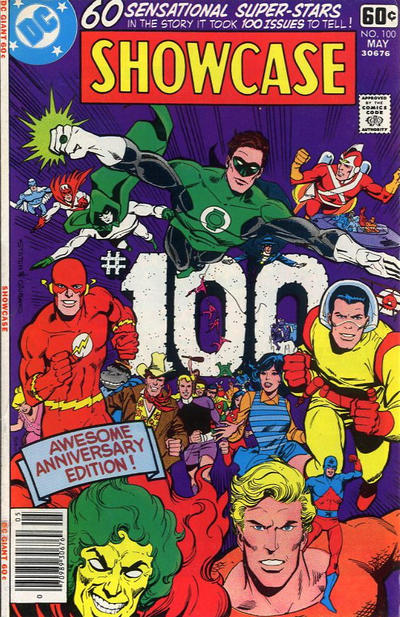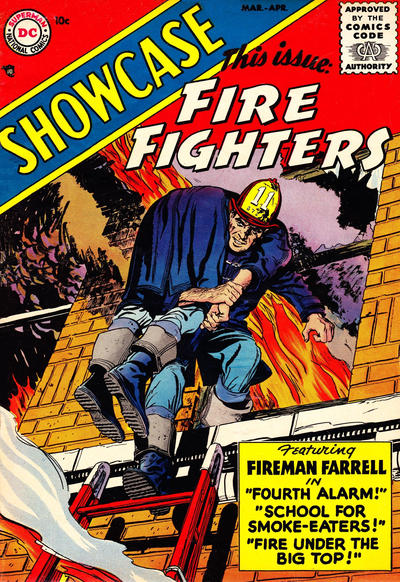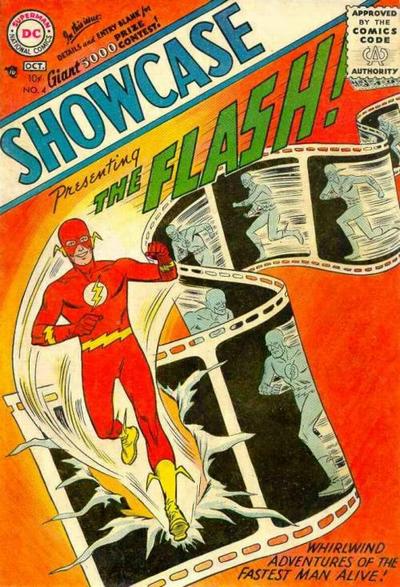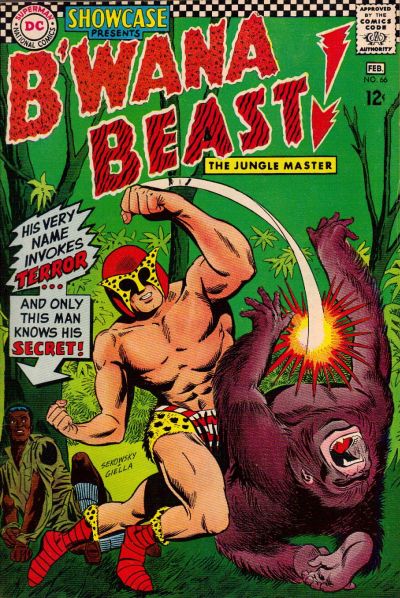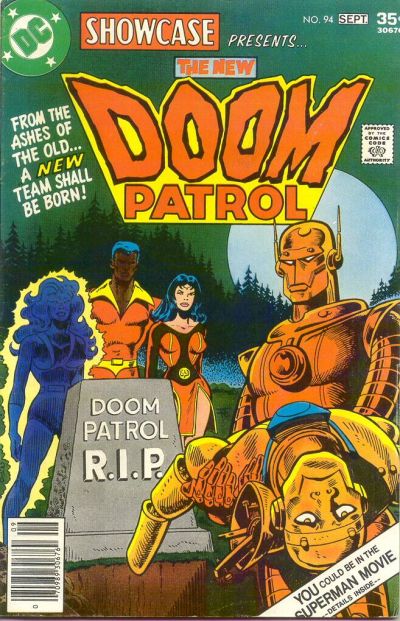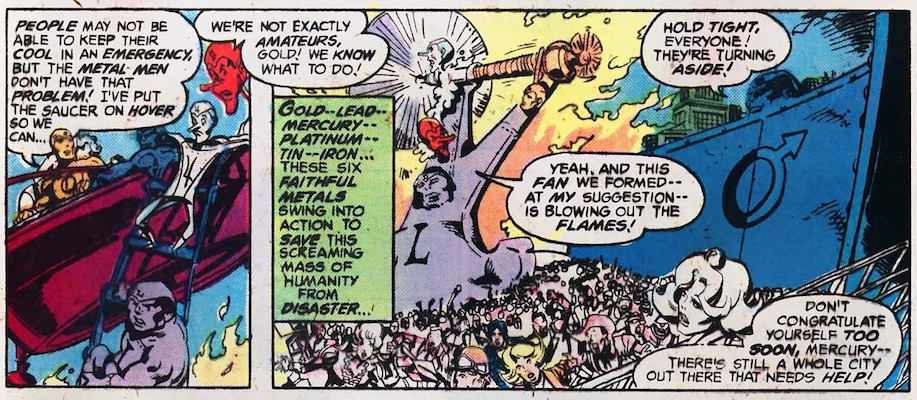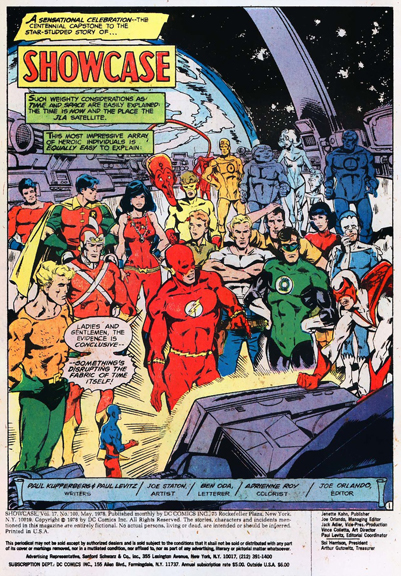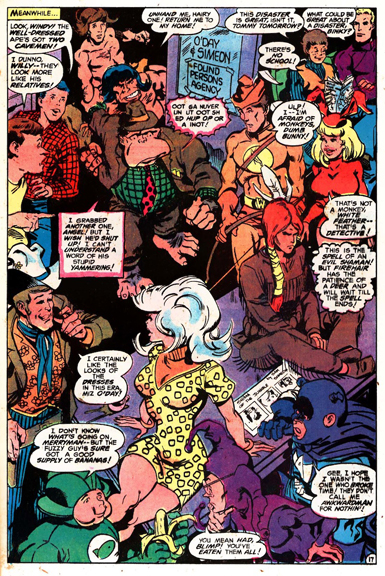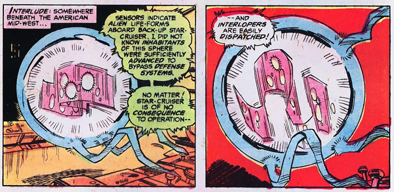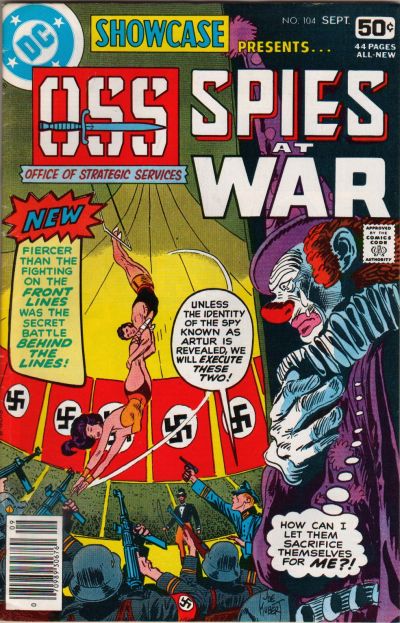COMIC BOOKS THAT TIME FORGOT: SHOWCASE #100
by KC Carlson
As some of you might know, I’m currently in the middle of reviewing all the DC New 52 #1 titles. So, looking for something a little more, ah… fun… to read during a break, I started thinking back to the period — way back in the 70s — where DC was doing a whole bunch of crazy one-shot stories in the pages of their various anthology titles. A lot of these stories are kind of “lost” because a lot of today’s fans don’t know about them — mostly because they were never reprinted (and probably never will be).
I thought this might be a good basis for a series of columns based on these “lost” stories, and luckily, Roger agreed. In fact, he remembered a columns= that he had done on Micronauts and Shogun Warriors that might also be forerunners of the concept, as they were both series originally tied to a licensing agreement that prevented them from ever being reprinted. As I thought of even more old Marvel titles in reprint limbo (or just in regular limbo for various reasons) — as well as all the great indy series of the past, some never concluded — well, this is a series of columns that could run for a very long time.
After telling Roger that I thought it was an idea big enough for everybody, we’re both hoping that some of the other Westfield writers take a turn from time-to-time to talk about their old favorites. In this column, I’ll be looking at Showcase #100, a double-sized issue (costing only 60¢) from May 1978 featuring a whole boatload of born-in-Showcase characters in a cool, wacky, fun story with an unusual ending.
Welcome to COMICS BOOKS THAT TIME FORGOT.
BUT FIRST A WORD ABOUT SHOWCASE
Awesome.
Okay, you’re probably going to need a few more words….
Comic book anthologies have existed since the beginning of comic book time. Many of the first comics of the Golden Age were anthologies — Detective Comics, Adventure Comics, Action Comics, Marvel Comics/Marvel Mystery Comics, and Whiz Comics, among others. But Showcase was one of the first anthology comics that was a little different. It was actually an anthology series, with no fixed starring character. Basically a try-out title for new series and concepts, the original Showcase featured no character for more than four issues in a row.
It wasn’t an entirely new idea. Dell’s Four Color series, which began in 1939, was also an anthology — consisting of everything from Disney Ducks to Hanna Barbara Hounds to Westerns to TV and movie adaptations. (Since DC recently stopped the ongoing numbering of Action and Detective, Four Color is now the undisputed record-holder for most consecutively numbered issues, publishing well over 1,000 individual issues, despite the fact the series was discontinued in 1962. How they got there: they often published several issues every month.) The thing about Four Color is that you would have never known that it was a series of comics unless you read the indicia. The individual covers gave no clue that that was the series title.
Another long-running classic anthology series was Classics Illustrated, which began in 1941.
BACK IN A FLASH!
Showcase is often associated with the Silver Age of Comics, but technically, it began in the the twilight of the Golden Age. Showcase #1 was cover dated Mar.-Apr. 1956. Showcase #4 (October 1956) is cited by many comic book historians as the first book of the Silver Age, because it not only starred a new version of The Flash, but it also indicated an actual break between that older era and implied a new era beginning. In the origin story, Flash-to-be Barry Allen is shown reading a comic book of the adventures of the Golden Age Flash — and is inspired by him to become a superhero after he gains speed powers in a combination lightning strike/chemical spill. At this point, Barry just thinks of that Flash as a fictional character dreamed up for comic book adventures. This single brief mention would ultimately spawn entire multiverses (multiversi?) of costumed adventurers in just a few years.
This new Flash would appear in four Showcase issues (#4, #8, #13, and #14) over the next two years. DC was being quite cautious before launching a brand-new superhero, but eventually, this new Flash was awarded his own comic book in The Flash #105 (March, 1959), continuing the numbering of the previous Golden Age Flash series. (It’s astounding to me that the company took two years to develop what we know today as a dynamite new superhero concept. That kind of time is unheard of in today’s market.)
Personal aside: Now that today’s comic historians can reasonably guess when older comics actually became available in the marketplace (this information was seldom public knowledge), we now can estimate that Showcase #4 probably first went on sale on July 19, 1956 — exactly one week after the day I was born. Obviously, I was too young to hop on my trike and peddle down to the local mom and pop store to pick it up. But I always wondered why I had such an affinity for DC’s Silver Age comics — especially The Flash — and now I’m wondering if there may be some sort of cosmic reason for that.
SHOWCASE FIRSTS
Besides the Flash, Showcase featured the first appearances of the Challengers of the Unknown, Space Ranger, Adam Strange, Rip Hunter: Time Master, the Silver Age Green Lantern, Sea Devils, the Silver Age Atom, the Metal Men, the Inferior Five, the Creeper, Anthro, Hawk and Dove, Bat Lash, and Angel and the Ape.
In addition, Lois Lane, Aquaman, and the Spectre all appeared elsewhere first, but their Showcase appearances directly led to their own series. Other characters like Tommy Tomorrow, Cave Carson, Enemy Ace, Teen Titans, B’wana Beast, Johnny Double, Dolphin, Phantom Stranger, and Firehair all made important appearances in Showcase while finding success elsewhere as back-ups or supporting characters. The Teen Titans appearance in Showcase #59 is notable as their second as a team, and the first for Wonder Girl (Donna Troy). Also, James Bond’s first American appearance in comics is Showcase #43, reprinting a British adaptation of Dr. No.
All of these first appearances qualify Showcase as one of the most important (and most collectible — as well as probably the most expensive to collect) comic book series in history. If not the most unique.
Not every feature in Showcase was successful — especially the first three: Firefighters (w/Fireman Farrell) in #1, Kings of the Wild (featuring Rider of the Winds) in #2, and the Frogmen in #3. But at least one of these forgotten features appeared in Showcase #100.
THE STORY IT TOOK 100 ISSUES TO TELL!
(Snark alert: And here I thought that Decompressed Storytelling was a relatively new development…)
Before Showcase #100 could be told, the series would first have to be revived, since it was canceled with issue #97 in 1970. The final original Showcase feature: the unsuccessful (and unfinished) Manhunter 2070. (I keep hearing rumors he will soon be reappearing somewhere at DC in the — hopefully — near future.)
Showcase was revived in 1977 with two great DC concepts: #94-96 revived the (supposedly dead) Doom Patrol with mostly brand new characters by Paul Kupperberg and Joe Staton. #97-#99 provided additional background and origin details for Power Girl by Paul Levitz and Joe Staton. Both series were well-recieved by fans, but neither feature graduated to its own series. Showcase #100 was next — what to do?
According to a Paul Levitz text page in the issue itself (thankfully it wasn’t on the internet instead of in the book, or it might have gotten lost in the subsequent 33 years), the concept of teaming the successful graduates of Showcase for a double-length story came first — then they had to find somebody to write it
A little less than a year before Showcase #100, Steve Englehart and Dick Dillin pulled off another audacious story, similar in scope, in Justice League of America #144. That issue told the untold tale of how the JLA really first got together — along with other famous early Silver Age DC characters like the Challengers and Blackhawks. (It was an early retcon in the original meaning of “retroactive continuity”, before the term came to imply contradicting previous comics.) But that story only featured 30 heroes! Yet it was one of DC’s best stories ever up to that time. My ever-fading memory tells me that JLA #144 has also never been reprinted (yet), so look for a future rundown of it here, one of these days.
But Englehart was leaving comics at that point and wasn’t available to tackle a big story like Showcase #100. Neither was Len Wein, who was then working at Marvel. With the obvious choices not available, the powers that be started looking around at the current staff — and landed then-Editorial Coordinator Paul Levitz himself, who was then busy writing the Legion of Super-Heroes, an all-new Legion Treasury , Justice Society of America, and three issues of Power Girl for Showcase. So Paul enlisted help in the form of buddy (and mega-Showcase fan) Paul Kupperburg. If we are to believe Levitz’s editorial note, he foisted most of the work upon Kupps (which probably didn’t bother him at all).
Finding someone to draw 34 pages featuring 60 main characters wasn’t going to be easy, it was assumed, but apparently, Joe Staton volunteered to pencil and ink. As if this wasn’t insane enough, Staton elaborated on the original plan of using just the successful Showcase characters, deciding to slip in many of the also-ran characters as well (including a couple of non-Showcase DC stars). Most of these are just cameos, including a panel on page 8 which includes a bunch of Showcase hopefuls (including Nightmaster, Jason from Jason’s Quest, and others), buried — but kind of identifiable — in a huge crowd scene. I think I might also spy with my little eye a Maniak or two in that panel.
The text page provides a handy identification guide to all 60 main characters, in order of their appearance, including the page number — remember them? — where they first appear, as well as the Showcase issues they first appeared in. I miss text pages in comics.
STORY? WHAT STORY?
The story itself starts out on a page that fans would would see numerous times in DC’s future (preceding Crisis on Infinite Earths by several years) — hordes of heroes gathered on the JLA satellite. The Page 1 splash includes (in no particular order) Atom, Aquaman, Adam Strange, Flash, Green Lantern, Hawk and Dove, Rip Hunter and his crew, the Teen Titans, and the Metal Men. Flash announces that time itself is askew — handily demonstrated in a panel including Johnny Thunder (known as Top Gun, the western hero in Showcase reprints), Anthro, Sgt. Rock, Enemy Ace, and Fireman Farrell — and then Adam Strange becomes designated party-pooper when he announces that not only is time screwed up, the Earth is being dragged out of its orbit. Bummer.
As the heroes of that era were wont to do, they split up into teams to investigate. The science guys (Flash, Atom, Adam Strange, Green Lantern) head to space, the Metal Men are assigned crowd control in Metropolis, and Rip Hunter does what he does best — gets the Time Sphere stuck in a disturbance in time. (In a story loose end, they never come back to him, just leaving him stuck out there.) Meanwhile, Lois Lane goes on TV to report the dire news and make a plea for Superman to show up for assistance. (He never does. Amazingly, this is one big hero-fest that does not include Superman or Batman.) Instead, she is accosted by Jack Ryder (aka the Creeper) looking for info, and instead of Superman, the Challengers of the Unknown show up. Another sub-team is born.
The science guys are rescued by Space Ranger (and his pink pal Cryll) who find a big creepy space monster and quickly shut it down. Unfortunately, the Earth is still hurtling through space at faster-than-light-speeds (which it does every day, but nevermind…).
Meanwhile, there’s a party at the offices of O’Day and Simeon (better known as Angel and the Ape), and all the cool guys and gals are there, including the Inferior Five, Anthro and his dad, Bat Lash, Firehair, Tommy Tomorrow, Binky, and Windy and Willy (aka Dobie Gillis and Maynard G. Krebbs, but that’s a long story). It’s the comic relief part of the story, so kick back and have a laugh or two while Sam gets really annoyed. Tommy, Bat, and Angel split to pinpoint the source of the disturbance in Tommy’s futuristic rocket ship. At the same time, Aquaman has joined with the Sea Devils for some ocean rescues, and Dolphin helps out in a really tight spot.
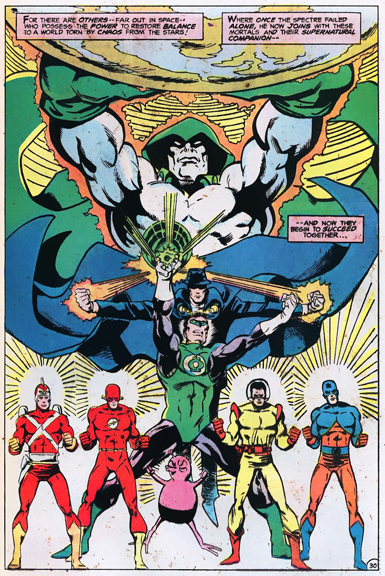
Page 30: Pre-Crisis DC: Where thinking real hard can stop an alien attack on Earth. Gotta love Cryll.
There are more cameos on Page 21 of Jonny Double, King Farraday from Danger Trail — repackaged for Showcase as I-Spy — and Manhunter 2070. We also check in with the Metal Men, Teen Titans, and Hawk and Dove, before heading back to space to discover that both the Spectre and Phantom Stranger have hooked up with those guys. They provide the heavy lifting for what needs to be done out there, with the rest of the A-Team space crew providing some much-needed brain-amplified back-up. (They all think really hard together.)
The Challengers, Creeper, and Lois Lane then discover what appears to be the source of the Earth’s problem — a mysterious monolith. The menfolk use teamwork to pry the door open , while impulsive Lois leaps through the opening just as it snaps shut again. Just out of sight, Tommy, Bat, and Angel land on top of the same monolith. They draw straws to see who goes in. Angel “wins” and also dives into the monolith before Tommy can stop her.
Thus, fate has transpired to make two non-super-powered — but highly capable — women Earth’s only hope in finally defeating the alien overlords. Interestingly, we never learn these aliens’ names, or where they come from , but in the couple of times that Staton draws them, they appear to look like shimmering unrolled sheets of wrapping paper. Ooo, scary. Lois Lane, at least, is well-versed in superheroics, and she quickly takes charge of the situation. But it all comes down to the actions of Angel O’Day , a private detective often thought of (and portrayed) as a stereotypical bimbo, to save the planet — with the timely assistance of a mysterious someone wearing white gloves. (Mickey Mouse?)
As the adventure ends and the time-displaced characters return to their rightful eras, the Phantom Stranger pops in with one of his pithy little speeches about fate and unanswered questions, while Lois and Angel hug in exhaustion. They saved the world — perhaps the universe — but no one may ever know of their heroism.
So, okay, it may not be the best story, or the most cosmic, or even make that much sense, but at that point in time in comics history (pre-Crisis), it was a real treat (and rarity) to see so many characters all come together in a single stand-alone story. How often do you see that nowadays? Oh, and before anyone asks where exactly this story fits into DC continuity, a subsequent lettercol explains that the story is “non-canon” and “just for fun”. Wow, what a concept. Who would have thought comic books could be fun!
Thanks Paul, Paul, and Joe! You made a lonely day in 1978 a little bit better!
AFTERMATH
Following Showcase #100, Hawkman reappeared for a great three-issue story by Jack C. Harris, Al Milgrom, and Murphy Anderson in #101-103, and then OSS: Spies at War appears in Showcase #104. That was a war series about a group of WW II spies that eventually morphed into Argent, tangentially tied into Suicide Squad. But none of that is in here.
#104 would turn out to be the last issue, as Showcase fell victim to the 1978 DC Implosion, the mass cancellation of close to half of DC’s line due to unstable business and economic concerns. What would have been Showcase #105 (Deadman) would show up, slightly edited, in Adventure Comics, and both it and #106 (The Creeper) would ultimately end up in DC’s extremely limited (but frequently photocopied) publication Canceled Comics Cavalcade. Two other series were planned for Showcase: World of Krypton, which became DC’s first three-issue miniseries in 1979, and The Huntress, who would have spun out of her feature in Batman Family. Instead, she eventually appeared as a critically acclaimed back-up feature — mostly by Paul Levitz and Joe Staton — in Wonder Woman in the early 1980s.
And that was it for Showcase. The title was revived for a series of anthology series, usually starring one of DC’s “big gun” characters and featuring little-seen characters as back-ups, from 1993-96. (With the addition of the year, the book became Showcase ‘93, Showcase ‘94, etc.) More recently, the name has been revived as a blanket title for DC’s series of “phonebook”-style reprint collections, as Showcase Presents.
Wouldn’t it be cool if Showcase Presents Showcase reprinted the entire series (or at least the ones that never got reprinted elsewhere)?
FOR FURTHER READING: Track down a copy of The Essential Showcase 1956-1959 (now sadly out of print) for a great 192-page collection of Showcase’s best stuff (including the little-seen complete Showcase #1 featuring Fireman Farrell). It also contains selected Flash, Challengers, Lois Lane, and Adam Strange stories, plus a detailed history of the origins of Showcase written by Paul Kupperberg. It looks like it might have been intended as the first volume in a potential series of Showcase collections, but apparently sales (or interest) were not there to continue.
For another review of Showcase #100, check out Rob Kelly and friends’ The Aquaman Shrine featuring more artwork from the issue, as well as Staton’s cover sketch for the issue. (And spend some time snooping around there — lots of fun stuff!!)
KC CARLSON: Older than dirt! (Wish I knew how to make a sound chip of that!)
Classic comic covers are from the Grand Comics Database.

